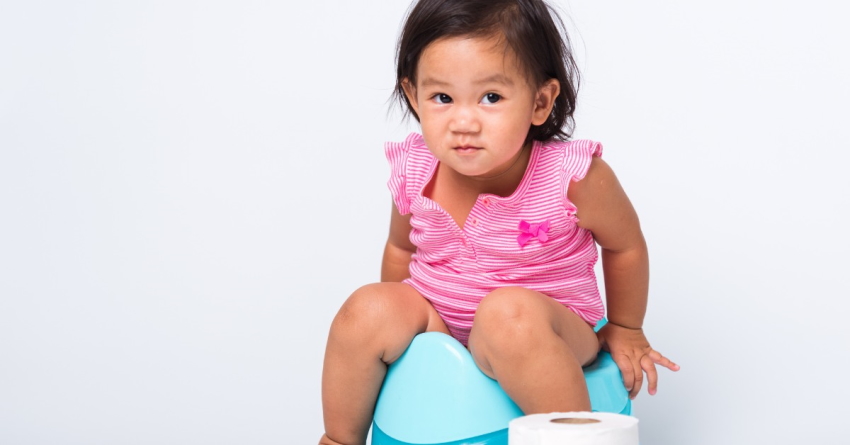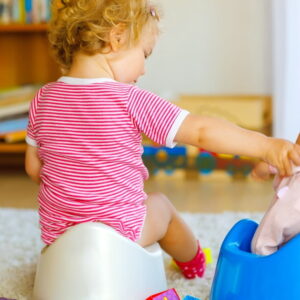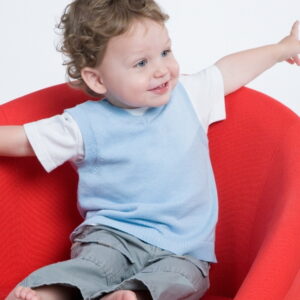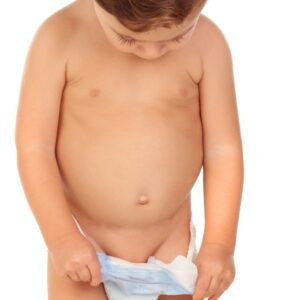There are several potty training methods – from slow to very quick. Each comes with certain pros and cons. Here, we go through the four most common methods – infant toilet training, child-oriented potty training, the 3 days potty training method, and the fast track 1 day potty training.
Depending on your goal and keeping your child’s characteristics and best interest in mind, you can then choose the approach you want to try.

The Four Most Common Potty Training Methods Explained
1. Infant toilet training
Although this method includes the word “training” in its name, this isn’t potty training in the typical sense. It is important to emphasize that the goal of infant toilet training is not complete control over the bladder and bowels because it is also not possible for children to obtain full control at such an early age. Instead, the goal is to achieve more predictable patterns and relative dryness with parental assistance. That means that using this method won’t lead to the baby being trained in the same way as it is possible with older children because some key developmental milestones need to be achieved for the child to be able to be fully potty-trained.
Infant toilet training is more practiced in traditional cultures but is also getting more recognized in Western cultures.
How does it work
The parents learn to read their baby’s cues to recognize when their infant needs to empty the bladder or bowels. In addition, the parents pay attention to timing, observing when their baby usually eliminates. By paying close attention, parents are able to recognize their baby’s patterns which helps them anticipate when the baby will need to urinate or defecate.
When the baby shows they need to go, the parent holds them bare-bottomed over a preferred target.
Additionally, in many parts of the world, parents use a vocalization or make a gesture while the baby voids in order to teach the baby to associate the sound with an action. This is also known as elimination communication. Once the baby associates the two, the parent uses it to signal the baby to eliminate, and eventually, the baby learns to pee or poop on cue.
Pros of infant toilet training
- Toilet sessions are more predictable
- Reducing or eliminating diaper usage at an early age
- Some research shows that infant toilet training may help babies learn how to completely empty their bladder when they urinate, which may lower the likelihood of urinary tract infections
Cons of infant toilet training
- Babies can’t be fully potty-trained, and it will take quite some time until they are able to go to the toilet independently
- Time-consuming
- It can be quite messy
2. Child-oriented potty training
Child-oriented approach to potty training is supported in the pediatric literature and by the American Academy of Pediatrics. It was developed by pediatrician T. Berry Brazelton who was concerned that parents are pushing their children to use the potty before the children are ready and are often using rigid tactics.
How does it work
In this gradual toilet training approach, the main idea is to let the child decide when they are ready to potty train and at what pace they will progress. This method allows parents to wait for the child to show interest and physiological and psychological readiness.
To start with this method, you should introduce the potty sometime after the child is 18 months old. When you introduce the potty, explain what it is for and try to help your child learn the connection between the potty and the real toilet. Some recommend keeping the potty in the bathroom to make this association clearer.
To get the child used to sitting on the potty chair, you should encourage them to sit on the potty, fully clothed, every day. This can be done in the bathroom at the same time while you are using the toilet, or it can be done in another room in the house. While the child sits on the potty, read or talk to them, or give them a small treat. However, if the child wants to leave at any point, let them.
After a few weeks of practicing this, start removing your child’s diaper before they go to sit on the potty. Encourage them to sit on the potty, but don’t expect them to actually pee or poop at this point.
When your child pees or poops in the diaper, take the diaper and put it in the potty while explaining to your child that this is where pee and poop go.
As the child becomes interested and more confident, start removing their diaper for short intervals during the day. Keep the potty near and encourage your child to use it. It is also okay to use gentle reminders.
If this is successful, you may consider using disposable or cloth training pants so the child can practice pulling them up and down.
Other important aspects of this method include using praise throughout the process while avoiding shaming or punishing and stepping back or pausing if the child resists.
Pros of child-oriented potty training
- It makes the process less stressful for the child
- Less resistance because the child is setting the pace
- A high success rate
- Gentle approach
Cons of child-oriented potty training
- It may take longer until the process is complete
- Parents may get frustrated when the progress seems slow
- A potential lack of consistency may also cause frustration in parents
- It may be difficult to use if the child is in daycare
3. 3-day potty training
The 3-day potty training method is an approach developed by Lora Jensen. This approach also emphasizes positive reinforcement, consistency, and patience. It is advised to first try using this method when your child is developmentally ready to potty train.
One of the first signs, according to Jensen, that tells you your child may be ready is when they are able to consistently communicate what they want, even if they aren’t using speech for it. She also advises waiting until the child is able to go to bed without a bottle or a cup.
Finally, Jensen suggests potty training when the child is around 22 months old. Except for these signs, you should probably also consider the signs of readiness (or at least some of them) that we listed here.
How does the 3-day potty training method work
Using this method requires some planning. First, choose any three consecutive days while keeping in mind that it is important to choose the days that will allow you to pay close attention and be fully focused on your child. For these reasons, it is possibly best to choose the weekend when you can spend most of your time at home.
Buy some things you will need, such as “big boy/girl underwear,” liquid (to create opportunities for potty breaks), snacks (you’ll spend a lot of time at home), and treats/rewards (optional).
Buying a potty chair is optional, as some recommend it is better to teach your child to use the standard toilet immediately, for which you can use a potty-seat insert on your toilet. Others advise starting with a potty first because it allows the child to keep their feet on the floor, which will help them learn the proper position and facilitate the activation of the lower pelvic area.
Furthermore, Jensen suggests buying one potty and keeping it in the bathroom so that your child can make the association between the potty and going to the toilet. However, you can also place the potty elsewhere in the home.
It is advised to ditch the diapers completely and leave your child bare-bottomed or dress them in underwear. You can ask the child to help you throw away the diapers, which may help them make a connection and understand better what is happening.
Day 1
When your child wakes up on the first day of training, remove their diaper and leave them bare-bottomed or dress them in the underwear you have bought. Explain to your child that they don’t need to use the diaper anymore and can now use the potty when they need to pee or poop.
Give your child more fluid than usual, so they would need to use the potty more often.
Throughout the day, pay attention to your child and watch for cues that say they need to use the potty. When you see your child needs to go, take them to the potty and say something like “Pee and poop go in the potty.” If they are successful, you can give them a small reward (optional). Whether you use rewards or not, make sure you celebrate their successes, so they feel it is a big deal.
This process should be continued throughout the day. Another thing you should decide on is whether you’ll use reminders or not. Jensen suggests reminding (not asking) your child frequently about the potty, saying something like, “Let me know when you need to use the potty.” By not asking and instead only reminding them, you are giving your child a sense of more control.
Take your child to the potty and encourage them to pee before naps too. Whether you’ll use the diaper for naptime is your decision. Jensen recommends ditching the diapers completely from the start and leaving your child without diapers during naptimes and nighttime so that the child doesn’t get confused.
However, research has shown that nighttime readiness differs from daytime readiness, and it usually takes longer until children are ready to stay dry at night. If you want to wait with the nighttime potty training, encourage the child to use the potty once more before bedtime and then put them in diapers during the night. If you decide to try going diaper-free during the night immediately, limiting the liquid before bedtime is probably a good idea.
Day 2 & 3
Repeat the same process from day 1. Your child may already start to communicate in some way when they need to go.
If you decide to go out at some point, take a portable potty with you or explain to your child that you’ll take them somewhere inside when they need to go potty.
With this method, parents need to be prepared for accidents, possibly many. It is really important not to shame your child or yell when they have accidents. If your baby starts to pee (or poop) when they are not on the potty, pick them up and carry them to the potty to finish. This part is important because Jensen says it helps teach your child to recognize their own physical needs.
Be patient and gentle, and make sure to offer a lot of praise throughout the whole process.
Pros of 3-day potty training
- A quick method
- For some parents, it can be less frustrating than the longer, child-led process
Cons of 3-day potty training
- Time-consuming
- Requires clearing the schedule for three days
- Many accidents, so it will probably be messy
- Some experts advise against it because it may cause anxiety and stress both for children and the parents
4. Toilet training in a day (Fast-track methods; Parent-led approach)
There are various fast-track methods, but probably the most famous is the one by Nathan Azrin and Richard Foxx, two psychologists whose book, “Toilet Training in Less Than a Day,” was released in 1974.
This is a parent-led approach, and its main idea is teaching children to use the potty through repetition. Azrin and Foxx also suggest waiting until your child is ready to start the potty-training process, which, they indicate, is when a child is over 20 months of age.
- They recommend watching for signs of readiness that include your child being able to:
- Recognize having a full bladder and appearing to know they need to pee or poop
- Keep their diaper dry for several hours
- Sit, stand and walk independently
- Pull the training pants up and down
- Follow simple instructions
- Point at various body parts
- Pick up objects
How does it work
To prepare for this method, you should schedule a time when both you and your child can fully focus. You should have at least 6 hours without any distractions.
Choose an area that will be easy to clean because there will be accidents.
Out of supplies, you need a potty chair, a doll that wets (or if not possible for you to find, use a regular doll, and you can probably make it look like the doll is peeing), food, and drinks.
Dress your child only in loose-fitting training pants, no top, to make it easier for the child to pull the pants down quickly.
Part 1 — Using a doll to demonstrate
The idea behind this part of training is that a child also learns by imitation.
Start by giving the doll something to drink, and then tell your child that the doll needs to potty. Next, guide your child through the entire process of removing the doll’s diaper, placing her on the potty, waiting for the doll to urinate, praising and rewarding the doll, emptying the potty in the toilet, and flushing the toilet.
You should also include checking for dryness. Ask your child to check if the doll’s pants/underwear are wet. If it’s dry, the child gives her the treat and praises her. If it is wet, show displeasure and explain that big kids don’t wet their pants (this part of the method is very questionable, in my opinion, and I wouldn’t use it). Immediately use correcting behavior and repeat the entire potty routine.
The doll should be used for demonstration until the child understands the process and learns the steps.
Part 2 — Training the child
Once your child has learned the steps with the doll, the next phase starts.
Give your child plenty of fluids to ensure they need to urinate more frequently. When you notice your child needs to go, take them to the potty.
Take your child to the potty when they need to go or otherwise every 15 minutes, and encourage your child to sit on the potty for several minutes. Encourage your child to pull down and up their pants independently as they did with the doll.
Ask your child to empty the potty in the toilet.
Regularly ask your child if their pants are dry and encourage them to check. If their pants are dry, praise and reward them.
When your child successfully urinates or defecates, praise and reward them. Also, praise them throughout the process for each step they successfully do.
If a child wets their pants, use corrective steps as you did with the doll.
Use gentle manual guidance to help your child carry out a certain action if needed.
Pros of Azrin and Foxx method
- If effective, this method is very quick because it takes only one day to potty-train a child
Cons of Azrin and Foxx method
- Various professionals are criticizing the method because it includes using reprimands
- It may not be suitable for all children
Toilet Training: Which Method is Best?
So, of all these potty training methods, which is the best? The obvious answer is – the one that works for your child! Some children are ready and highly motivated and in such a case a quick method like the 1 or 3-day potty training methods can work just fine. For other children, potty training will be a slow process and trying to force them is highly likely to backfire.
My personal view is that you should let your child lead the way, whether it take 1 day or several months. Do not create expectations for yourself on timing and process. Do not allow yourself to become frustrated and certainly not to show your frustration to your child. Your child will not be in diapers when they’re teenagers, so at some point the diapers are just a memory.
Potty training in a positive parenting way
If you want to ensure you are potty training your child using gentle and positive parenting way, there are several guidelines to follow:
- Make it a positive experience
- Don’t pressure your child to potty train before the child shows readiness
- Even if your child shows signs of readiness, they may still be resistant, which is okay
- If you experience power struggles, it is better to wait a bit more, maybe a few weeks, then try again
- Talk about the toileting process and/or read books about going potty
- Encourage the child to try sitting on the potty, even when fully clothed or in their diaper
- Model the behavior
- Avoid shaming and instead use gentle direction
- Use praise and small rewards (if you plan to use rewards), but make sure that praise is specific, immediate, and not too focused on the success (praise the process and the effort as well)
- Be patient and consistent
Takeaway
As you can see, there are many potty-training methods to choose from, all of which come with their own pros and cons. Keep in mind that potty training is not one-size-fits-all, and you should choose what you believe is best for your child.
Regardless of which potty training method you use, it is important to keep in mind to use a positive parenting approach to potty training to avoid power struggles and negative feelings around the whole process for your child.
Read Next
- How to Prepare for Potty Training
- When and Why to Potty Train
- 1-Year-Old Baby Refuses Diaper Change: Tips on What to Do!
Research
- Kaplan, A. (n.d.). Azrin and Foxx Method: “Toilet Training in Less Than a Day.” Potty Genius.
- Child Development and Family Center. (n.d.). All about potty training.
- Choby, B. A., & George, S. (2008). Toilet training. American Family Physician, 78(9), 1059-1064.
- Dewar, G. (2020, May). “Fast-track” toilet training techniques: An evidence-based review. Parenting Science.
- Dewar, G. (2020, September). Infant toilet training: The scientific evidence.

Paula Dennholt founded Easy Baby Life in 2006 and has been a passionate parenting and pregnancy writer since then. Her parenting approach and writing are based on studies in cognitive-behavioral models and therapy for children and her experience as a mother and stepmother. Life as a parent has convinced her of how crucial it is to put relationships before rules. She strongly believes in positive parenting and a science-based approach.
Paula cooperates with a team of pediatricians who assist in reviewing and writing articles.







